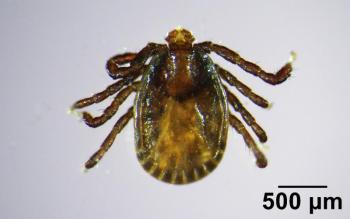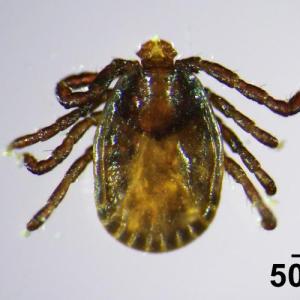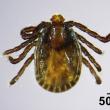UMaine Extension Tick Lab researchers confirm presence of invasive Asian longhorned tick in Maine
ORONO — The University of Maine and the Maine Department of Agriculture, Conservation and Forestry (DACF) have confirmed the presence of an invasive Asian longhorned tick (Haemaphysalis longicornis) in the state for the first time.
The tick was submitted through University of Maine Cooperative Extension’s passive tick surveillance program and identified by staff at the UMaine Extension Tick Lab. Follow-up active surveillance in the surrounding area did not detect any additional specimens.
The specimen, a nymph, was collected in Cumberland County and submitted for identification and pathogen testing. This marks the first known occurrence of the species in Maine and raises important considerations for livestock care, wildlife management and public health.
“This discovery underscores the critical importance of continued tick surveillance in Maine,” said Griffin Dill, director of the UMaine Extension Tick Lab. “While this appears to be an isolated case, we are closely monitoring the situation and coordinating with state and federal partners. Early detection is essential to understanding and mitigating the potential risks associated with this species.”
Why the Asian Longhorned Tick Is a Growing Concern
Native to East Asia, the Asian longhorned tick was first confirmed in the United States in New Jersey in 2017 and has since spread through more than twenty states. Unlike most ticks, female Asian longhorned ticks can reproduce without mating, creating infestations from a single individual and posing a unique challenge for control. The tick found in Maine was at a juvenile stage that can’t reproduce.
They feed on a wide range of hosts, including livestock, pets, wildlife and people. In other regions, they have been shown to transmit the cattle pathogen Theileria orientalis, which can cause significant illness. Research is ongoing to understand if this tick species can spread the pathogens found in Maine and elsewhere in the U.S.
In response to the recent finding, state and research partners are intensifying monitoring efforts to determine whether the Asian longhorned tick is persistent in Maine and, if so, to understand its potential spread. UMaine, DACF and the MaineHealth Institute for Research will continue targeted active surveillance in the region and encourage the public to remain vigilant.
How Maine Can Prepare
DACF, in collaboration with the UMaine Extension Tick Lab and Maine CDC, recommends these preventative measures:
-
Use tick preventatives: Veterinarians should advise on effective treatments for livestock and pets.
-
Conduct rigorous tick checks: Examine animals, especially ears, eyes, tails, and feet, regularly and remove any ticks found promptly and safely.
-
Maintain the landscape: Keep yards and pastures brush-free and create mulch or gravel borders to reduce tick habitat.
Continued Monitoring and Reporting
The presence of Asian longhorned ticks in Maine and neighboring states, along with the data from UMaine Extension’s ongoing passive surveillance program, highlights the urgency of staying alert.
“If you find an unusual-looking tick or suspect an infestation, don’t hesitate to report it to DACF,” said Dr. Rachael Fiske, assistant state veterinarian. “In this and every instance, early detection is key to protecting Maine’s livestock, pets, wildlife and public health.”
To report findings or for more information, contact the Maine DACF’s Animal Health Division, 207.287.3701; animalhealth.dacf@maine.gov.
For more information on tick species in Maine and submitting a tick for identification and testing, visit the UMaine Extension Tick Lab website at extension.umaine.edu/ticks. Additional guidance is also available on the Maine Center for Disease Control and Prevention website and the U.S. Department of Agriculture website.
Funding for ongoing UMaine research on ticks and tick-borne pathogens is supported by Congressionally Directed Spending secured by U.S. Sen. Susan Collins, currently chair of the Senate Appropriations Committee. Additionally, an annual state appropriation directly supports the operations of the tick lab and enables UMaine to maintain testing affordability for Maine residents.
About University of Maine Cooperative Extension
As a trusted resource for over 100 years, Extension has supported UMaine's land and sea grant public education role by conducting community-driven, research-based programs in every Maine county. UMaine Extension seeks to build thriving communities and help grow the food-based economy. Extension also leads Maine’s 4-H program, the most successful out-of-school youth educational program in the state. 4-H programs are grounded in the belief that kids learn best by doing and are developed to fit a variety of backgrounds, interests, budgets and schedules. Participants complete hands-on projects in areas like health, science, agriculture and civic engagement in a positive environment where they are encouraged to take on proactive leadership roles.
About the University of Maine
As Maine’s only public research university and a Carnegie R1 top-tier research institution, the University of Maine advances learning and discovery through excellence and innovation. Founded in 1865 in Orono, UMaine is the state’s land, sea and space grant university with a regional campus at the University of Maine at Machias. Our students come from all over the world and work with faculty conducting fieldwork around the globe — from the North Atlantic to the Antarctic. Located on Marsh Island in the homeland of the Penobscot Nation with UMaine Machias located in the homeland of the Passamaquoddy Nation, UMaine’s statewide mission is to foster an environment that creates tomorrow’s leaders. As the state’s flagship institution, UMaine offers nearly 200 degree programs through which students can earn bachelor’s, master’s, professional master’s and doctoral degrees as well as graduate certificates. For more information about UMaine and UMaine Machias, visit umaine.edu/about/quick-facts/ and machias.edu/about-umm/umm-facts/.




























